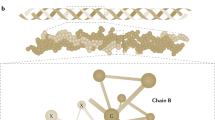Summary
Ehlers-Danlos syndrome (EDS) type IV is a clinically and genetically heterogeneous disorder characterized by thin skin, prominent venous vascular markings, markedly increased bruising, and an increased likelihood of large bowel and large artery rupture. We studied two type IV EDS patients. Both have decreased amounts of type III collagen in skin, but ultrastructural examination of dermis showed massive dilation of rough endoplasmic reticulum in dermal fibroblasts in one, but not the other. Both had a major population of collagen fibrils of small diameter. Although previous studies suggested absent synthesis of type III collagen as the hallmark of one type of EDS IV, several abnormalities in metabolism of that type of collagen may be responsible for the phenotype in these disorders. Such disorders are likely to provide better understanding of the function of specific collagens in tissues.
Similar content being viewed by others
References
Barabas, A. P.: heterogeneity of the Ehlers-Danlos syndrome; description of three clinical types and a hypothesis to explain the basic defect. Br. Med. J. 1967II, 612–613
Beighton, P.: The Ehlers-Danlos Syndrome. London: Heinemann 1970
Bornstein, P., Byers, P. H.: Disorders of collagen metabolism. In: Duncan's diseases of metabolism, eighth edition, P. Bondy and L. E. Rosenberg, eds. New York: Saunders 1979 in press
Byers, P. H., Holbrook, K. A., Smith, L. T., Bornstein, P., McGillivray, B., MacLeod, P. M.: Altered secretion of type II collagen in a form of type IV Ehlers-Danlos syndrome. Clin. Res. 26, 512A (1978)
Coulombre, A. J.: Problems in corneal morphogenesis. Adv. Morphog. 4, 81–109 (1965)
Cooper, R. R., Pedrini-Mille, A., Ponseti, I. V.: Metaphyseal dysostosis. A rough surfaced endoplasmic reticulum storage defect. Lab. Invest. 28, 119–125 (1973)
Epstein, E. H., Jr.: [α1(III)]3 Human skin collagen: Release by pepsin digestion and preponderance in fetal life. J. Biol. Chem. 249, 3225–3231 (1974)
Epstein, E. H., Jr., Munderloh, N. H.: Human skin collagen. Presence of type I and type III at all levels of the dermis. J. Biol. Chem. 253, 1336–1337 (1978)
Gay, S., Martin, G. R., Müller, P. K., Timpl, R., Kühn, K.: Simultaneous synthesis of type I and III collagen by fibroblasts in culture. Proc. Natl. Acad. Sci. USA 73, 4037–4040 (1976)
Karnovsky, M. J.: A formaldehyde-glutaraldehyde fixative of high osmolarity for use in electron microscopy. J. Cell Biol. 27, 137 A (1965)
Laemmli, U. K.: Cleavage of structural proteins during the assembly of the head of bacteriophage T4. Nature 227, 680–685 (1970)
Lapiere, C. M., Nusgens, B. V., Pierard, G. E.: Interaction between collagen type I and type III in conditioning bundles organization. Connect. Tissue Res. 5, 21–29 (1977)
Lieberman, J., Mittman, C., Gordon, H. W.: Alpha1-antitrypsin in the livers of patients with inherited emphysema. Science 175, 63–65 (1972)
Luft, J. H.: Improvements in epoxy resin embedding methods. J. Biophys. Biochem. Cytol. 9, 409–414 (1961)
Maynard, J. A., Cooper, R. R., Ponseti, I. V.: A unique rough surfaced endoplasmic reticulum inclusion in pseudoachondroplasia. Lab. Invest. 26, 40–46 (1972)
McKusick, V. A.: Heritable disorders of connective tissue, 4th edition. St. Louis: Mosby 1972
Miller, E. J.: Biochemical characteristics and biological significance of the genetically-distinct collagens. Mol. Cell. Biochem. 2, 165–192 (1976)
Nowack, H., Gay, S., Wick, G., Becker, U., Timpl, R.: Preparation and use in immunohistology of antibodies specific for type I and type III collagen and procollagen. J. Immunol. Methods 12, 117–124 (1976)
Pope, F. M., Martin, G. R., Lichtenstein, J. R., Penttinen, R. P., Gerson, B., Rowe, D., McKusick, V. A.: Patients with Ehlers-Danlos syndrome type IV lack type III collagen. Proc. Natl. Acad. Sci. UsA 72, 1314–1316 (1975)
Pope, F. M., Martin, G. R., McKusick, V. A.: Inheritance of Ehlers-Danlos type IV syndrome. J. Med. Genet. 14, 200–204 (1977)
Reynolds, E. S.: The use of lead citrate at high pH as an electron opaque stain in electron microscopy. J. Cell Biol. 17, 208–212 (1963)
Sack, G.: Status dysvascularis; ein Fall von besonderer Zerreißlichkeit der Blutgefäße. Dtsch. Arch. Klin. Med. 178, 663–669 (1936)
Thiery, J. P.: Microcinematographic contributions to the study of plasma cells. In: Cellular aspects of immunity, G. E. W. Wolstenholme and M. O'Connor, eds. Boston: Little, Brown 1960
Author information
Authors and Affiliations
Rights and permissions
About this article
Cite this article
Byers, P.H., Holbrook, K.A., McGillivray, B. et al. Clinical and ultrastructural heterogeneity of type IV Ehlers-Danlos syndrome. Hum Genet 47, 141–150 (1979). https://doi.org/10.1007/BF00273196
Received:
Issue Date:
DOI: https://doi.org/10.1007/BF00273196




